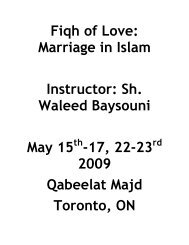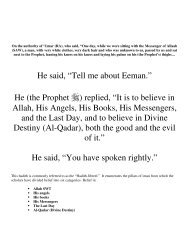TPA-PPN-Full-with-gl..
TPA-PPN-Full-with-gl..
TPA-PPN-Full-with-gl..
- No tags were found...
You also want an ePaper? Increase the reach of your titles
YUMPU automatically turns print PDFs into web optimized ePapers that Google loves.
Project Professional Notes9of hadeeth was not established. This was different from imaam Ahmed, who did not have such factors inMadinah.There were differences in the validity of the ahadeeth. Area of Iraq, for example, was troubled <strong>with</strong> muchfitna and fabraications and the Hanafi Madhab was affected. In contrast, the area of Hijaz was relatively safeand had much ahadeeth narrated to the scholars that Iraq would not receive.There were also differences in acceptance of hadeeth such as Imaam Ahmed, who accepted Mursal hadeeth(a type of weak hadeeth <strong>with</strong> Sahabah missing in the chain) while others did not.Finally, they had different ways of resolution to textile differences. For example, one hadeeth says to pray 2rak’as whenever you come to the masjid but another hadeeth says not to pray anything after ‘Asr. Whattakes precedence, the general commandment or the prohibition? And when you say you can’t pray anyprayer, does that mean any prayer, even if it had a reason? Imaam ashShafi’ee said you can pray any prayerthat has a reason while Imaam Abu Haneefah and Imaam Malik said nothing can be prayed in this time.4. Linguistic Differences –There were differences in the Ayaat and the Ahadeeth like “touching Women” breaks your Wudoo’. Doesthat mean just touching or sexual intercourse? Those who interpreted the Ayaat literally, like ImaamashShafi’ee, said that it was any physical touch. However, this is only if the women is a non-Mahram.They also had linguistic differences in grammatical meaning. For example, there is the word “bi” <strong>with</strong> wipeyour head. Does this mean wipe your whole head or is it a “bi” of partiality for wiping any part of yourhead? Imaam as-Shafi’ee said you can wipe part of your head. Also, there is the meaning of “hands up toyour elbows,” and does this include your elbows or just goes up to them?5. Juristic Method Differences –They had differences in their Usool, such as the Hanafis used a lot of Qiyaas in their Madhab to determinerulings. Some scholars said that any use of Rai’ was totally haraam.Imaam Maalik preferred the customs of the people of Madinah because he considered it to be the city inwhich Islaam was first established and its people are the ones who carried and preserved Islaam. But themajority of scholars disagreed <strong>with</strong> him on this as they said many Sahaabah had moved from Madeenah andmany other cultures had moved in.The scholars even differed on what type of Ijma’ should be accepted. Some said that there is no Ijma’ afterthe Sahaabah and whoever says there is, they are lying. But the most amazing thing about all thesedifferences is that they never affected the manners of the Imaams <strong>with</strong> each other. There was once a storyabout Imaam Abu Haneefah and a scholar who came from madeenah to debate him in an issue. They spokefrom Ishaa’ until Fajr in a private room and the people did not hear them raise their voices. They did notagree at the end and still they left each other <strong>with</strong> a brotherly hug and smile.





![FOL-PPN [Qabeelat Tayybah] - Qabeelat Wasat](https://img.yumpu.com/6133874/1/190x245/fol-ppn-qabeelat-tayybah-qabeelat-wasat.jpg?quality=85)